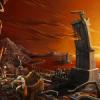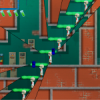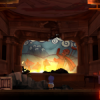Continuing directly where the original Deponia left off, Chaos On Deponia feels much the same as its predecessor, although it does improve on the original Deponia in several very important ways. Though innovative, these improvements don’t unfortunately mask the few flaws that prevent Chaos On Deponia from being truly great.
Structurally, the story is almost identical to the first game. The adventure begins in a town, the Floating Black Market, where the player will spend about half their time and will solve the majority of the game’s puzzles, some of which are of questionable relevance to the main story. Just as the story gathers momentum and the world opens up, the game ends. Not abruptly, but certainly a little before I would like it to end.
The story contains few references to the previous game, making Chaos On Deponia suitable even for those who missed the original, although some of the jokes, particularly those involving Toni, will only be appreciated by people who played the first game. A quick recap video serves to remind the returning player and inform the new player of the events in the original.
The Deponia series seems to take the same approach to story-telling and puzzle design that Rube Goldberg used whilst drawing his famous cartoons depicting overly complex machinery that was designed to achieve simple tasks in the most convoluted manner possible.
This philosophy actually serves Chaos On Deponia very well as it provides plenty of opportunity for the often witty, sometimes cringe-worthy, humor that characterized the entirety of the first game. The ‘Goldberg philosophy’ also provided plenty of room for Daedalic Entertainment to expand on the already varied character sheet, resulting in some truly amusing additions.
The entire character cast is a good mix of new faces and old. In a surprisingly refreshing move, none of the returning characters have had sudden personality changes with the exception of Goal who early on is split into three personalities: the starry-eyed Baby Goal, reckless Spunky Goal and cold-as-ice Lady Goal. But never mind Goal as the only women that Rufus truly deserves, Toni, makes an appearance later on in the game and, well, just tell her to “Drop and give me 20, recruit”. Her response is one of the best moments in the game.
Rufus is his usual gauche self, however he is also very difficult to dislike. His bungling arrogance stops well short of becoming obnoxious and Chaos On Deponia’s writers made great use of it in setting up ridiculous and amusing situations. Overall, Rufus is just competent enough to prevent the player from becoming frustrated with him, meanwhile his anti-charisma is, bafflingly, quite charming at times.
It would be fair to say that the Goldberg philosophy permeates every aspect of Chaos On Deponia. The puzzles themselves, whilst not fiendishly difficult, are not easy or boring, either. Despite the generally improved puzzle design, the puzzles throughout Chaos On Deponia suffer from the problems as some of the latter puzzles in the original Deponia; they contain elements that are neither logical, nor obvious.
A good example of this problem is the requirement to use a banana straightening machine during an attempt to recreate a Chaplin-esque slapstick sequence. This banana straightening machine is, to add further confusion, quite some way away from the actual puzzle area and is not something that the player will interact with for quite some time between its discovery and its use. In short, there is no way someone could reasonably be expected to work out that this is what is missing from the puzzle’s solution.
To compound this issue, Chaos On Deponia struggles in using dialogue to direct the player in subtle ways. Some puzzles are almost opaque in terms of their requirements and the lack of information available. The requirement to straighten the banana is one such instance; no hint is ever given that the banana should be straightened.
Despite these problems, Chaos On Deponia does contain some excellent puzzle design that often leads to a lot of amusement. Chaos On Deponia excels during the self-contained puzzles, with Daedalic often taking the opportunity to insert short sections of shenanigans that complement the story very well. The very first puzzle makes use of ironic gap to hilarious effect and, whilst Chaos On Deponia must be credited with exploring a wide range of different comedy styles, this is undoubtedly one of the best and funniest moments in the Deponia series to date.
The humor in Chaos On Deponia is not always as lighthearted, however. At some points, it could be described as being fairly grim. The nearest analogy would be The Simpson’s Itchy And Scratchy, but lacking the graphic hyper-violence – Chaos On Deponia does manage to remain relatively child friendly from start to finish, in spite of the odd delving into darker humor. Despite the contrast with the other gags, these sections don’t feel out of place or crass; they are just another style of comedy that is explored over the course of the game.
Following in the footsteps of Deponia, Chaos On Deponia uses mini-games to supplement the puzzles. The only problem with the mini-games is that there are so few of them. The mini-game design is generally interesting and serves to break up long sections of more conventional types of puzzling.
Chaos On Deponia contains few mechanical improvements over the original, indeed few were necessary, however the addition of the ‘Hotspot’ system alleviates the age old issue with point and clicks of not being able to distinguish interactive parts of the environment from the scenery. This is a feature that I made heavy use of during the course of the game and I believe that something similar should become a staple mechanic of the point and click genre.
Aesthetically, Chaos On Deponia looks even better than the original. Liberal use of a wider color palette helps to give each area its own distinct character and makes the world feel more alive however the backgrounds do feel like they lack activity at some points. This has the effect of giving the impression that the entire population of Deponia numbers in the dozens.
The improved aesthetic is complemented by the, again, much improved soundtrack. Those who liked the score from the first Deponia will likely love the new soundtrack. The bard-like narrator and his Choir Guys make a triumphant return and my only request is that they record an album, as they are a fantastic addition to the game.
Improving on the original in so many ways, Chaos On Deponia goes from strength to strength, thriving on it’s truly varied and often outlandish characters as well as the detail and charm of a world enhanced by a fantastic soundtrack. The sparse background animation, sometimes opaque puzzling and subtle lack of a sense of grand adventure prevent Chaos On Deponia from recognizing its full potential, although this should not be confused with the statement that Chaos On Deponia is not worth your time; it really is and I think fans of point and click adventure games will struggle to dislike it.
Score:
Score:








